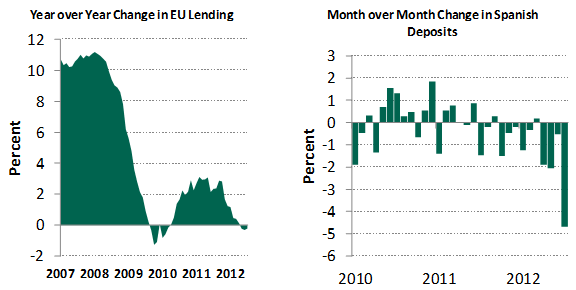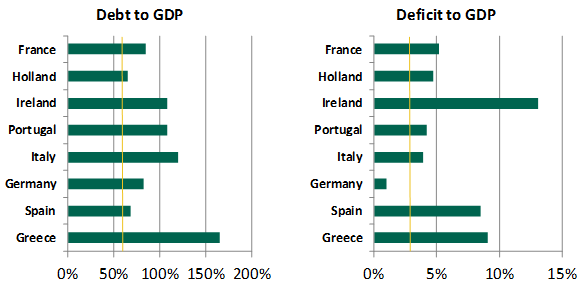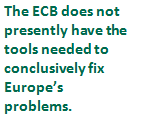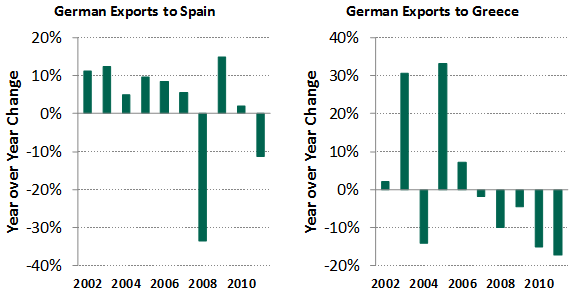The ECB: No Rest for the Weary
- The economic picture in Europe is worsening, exposing flaws in the foundation of the euro compact.
- The European Central Bank is trying its best, but remains hindered by its charter.
- European policy makers should focus on stabilizing the situation first, and seeking retribution later.
I worked for a European bank for many years, and I can tell you: August was not the best month to get something done. Many colleagues on the other side of the Atlantic took extended holidays at that time, leaving the halls at headquarters largely unattended. I suggested to my American boss that we adopt a similar regime, the better to appreciate the finer things in life. He responded that if I didn’t get back to work, I’d have the longest vacation I could imagine.
After a tense and volatile first half-year, European policy makers could be forgiven for taking some time away this August to recharge their batteries. Any restoration of calm was short-lived, however, because the problems they had left seemed even more vexing when they returned.
As the ECB governing council gathered this week in Frankfurt, they were facing escalating concern. Cumulatively, Europe’s economy contracted last quarter and the factory sector of the region has been mired in a severe slump for over a year. The European Purchasing Managers’ Index (PMI) has been holding below the critical mark of 50 (which denotes a contraction in factory activity) for thirteen straight months.

Labor market conditions are significantly weak. The overall unemployment rate of the Eurozone, 11.3% in July, is the highest since the formation of the single-currency area. The unemployment rate of Spain at 25.1% is the most severe among the troubled larger economies. To complete the tour around the periphery, Greece is grappling with a jobless rate of more than 23%, followed by 14.9% and 15.7% readings in Ireland and Portugal, respectively.
 The
recession, along with the associated bursting of property market
bubbles in several nations, has harmed Europe’s banks. Loan
losses have mounted, and regulatory attention has heightened.
Liquidity has been harder to come by, as investment funds limit
exposure to European names and depositors flee institutions in
places like Spain. As some struggle to survive, credit is
restricted to preserve capital.
The
recession, along with the associated bursting of property market
bubbles in several nations, has harmed Europe’s banks. Loan
losses have mounted, and regulatory attention has heightened.
Liquidity has been harder to come by, as investment funds limit
exposure to European names and depositors flee institutions in
places like Spain. As some struggle to survive, credit is
restricted to preserve capital.

Concern over the viability of key institutions is at a high level. When confronted with a comparable situation in 2009, the U.S. Treasury Department and the Federal Reserve conducted the first “stress test” of large banks, which initiated a lot of capital raising and raised transparency surrounding potential losses.
Europe has attempted several stress tests, but their lenient terms and limited disclosure have diminished their credibility. Many banks which passed the first test comfortably have subsequently required substantial support from their governments.
As most readers well know, the linkages between each nation’s leading financial institutions and its sovereign are very close. Large banks are expected to purchase copious amounts of government debt, while the state is often a direct or indirect stakeholder in its banking champions. So their fates are closely intertwined.
Rules requiring firms to keep up certain levels of reserves, liquidity, and capital even under duress act in a very procyclical way. When times are bad, these expectations can constrict credit to borrowers (in both the public and private sectors) at exactly the time it is most needed.
 Normally,
such dire circumstances might be grounds for fiscal stimulus.
But most countries in the eurozone are already well in excess of
the targets set out by the European Stability and Growth Pact in
1998. Ceilings of 60% on the ratio of government debt to GDP and
3% on current year budget deficits as a fraction of GDP were
established at that time. The need to move back towards
compliance with these strictures acts as a second layer of
procyclical policy.
Normally,
such dire circumstances might be grounds for fiscal stimulus.
But most countries in the eurozone are already well in excess of
the targets set out by the European Stability and Growth Pact in
1998. Ceilings of 60% on the ratio of government debt to GDP and
3% on current year budget deficits as a fraction of GDP were
established at that time. The need to move back towards
compliance with these strictures acts as a second layer of
procyclical policy.

Of course, budget deficits are the product of more than just a slow economy. The scale of government spending and employment in some countries was identified for reform when the euro was chartered, but little progress has been made on that front. The problem was muted by the strength of the European economy until 2008, but has come under a microscope since.
The austerity measures needed to bring deficits down are reinforcing the downward trend in European GDP. But the willingness to relent on belt-tightening for cyclical reasons is tempered by the desire to enforce structural reform on countries who transgressed most egregiously. This spirit is rooted not only in the terms of the Stabilization and Growth Pact, but also in economic culture of northern European countries like Germany, where fiscal rectitude and more limited government are key features.
So it is into this fray that the ECB has collectively jumped, trying to use monetary policy to offset the contractionary influence of European fiscal and regulatory policy. But in this endeavor, its capabilities are severely limited by its structure:
- The ECB has a single mandate, which is ensuring price stability. It has no formal responsibility for promoting economic activity, as the Federal Reserve does. And with European inflation trending a little bit above target, easing policy is more difficult to contemplate.
- The ECB does not have regulatory authority over European banks, and therefore has very little influence over the diameter of the credit pipeline.
- The charter of the ECB does not easily allow for the type of quantitative easing that the Federal Reserve has used so effectively since 2008.
And while not specifically a limitation of the ECB, the lack of consolidated or coordinated fiscal policy may have contributed to the challenges Europe faces today, and limits its ability to resolve them. The Stability and Growth Pact was supposed to serve as a lever in this area, but has been lightly enforced.
 Despite
all of these limitations, many seem to expect the ECB to act
with the same speed and force that the Federal Reserve did. This
may be a bridge too far. Nonetheless, Mario Draghi has adeptly
pushed through a series of new supports which have certainly
kept things from getting even worse.
Despite
all of these limitations, many seem to expect the ECB to act
with the same speed and force that the Federal Reserve did. This
may be a bridge too far. Nonetheless, Mario Draghi has adeptly
pushed through a series of new supports which have certainly
kept things from getting even worse.
The latest in this line was announced after the September ECB meeting: a program (Outright Monetary Transactions, or OMTs) which aims to purchase sovereign debt of up to three years in maturity. These bond buys are intended to limit financing costs for key countries and build confidence behind the notion that, in Draghi’s words, “the euro is irreversible.”
There was a dissent from the September decision, which observers assume came from Germany. Some German policy makers have been very vocal about their desire for tight fiscal restraint in peripheral countries as a prerequisite for OMT support.
But Germany has benefitted greatly from expanded exports to the periphery since the euro came into being, and the retreat in these exports since the financial crisis has hindered German economic performance. Should Greece or Spain leave the euro and devalue their currency, these trade flows would fall even more precipitously.

Further, it is hard to anticipate how the dominos might fall in an exit scenario. The lesson learned from the 2008 crisis is that exposure can turn up in the darndest places and defy efforts to contain the damage. Best, then, not to break the sixth seal in the first place.
Unfortunately, European policy makers are divided on the costs and benefits of various outcomes, leaving market participants confused and worried. Even the September 6 ECB announcement of OMTs, which some had hoped would be a decisive step, leaves a lot of details undefined. The program is critically contingent on the political process in key countries, and could therefore take some time to become effective. For a country like Spain, which faces significant debt rollovers in the coming two months, any delay would be very damaging.
Investor reaction, more often than not, has been to withdraw from the affected markets to await additional clarity. This has only served to deepen the challenge of recovery.
In sickness and in health, for richer or for poorer, and for better or for worse, the fortunes of Eurozone nations are now inextricably bound together. Ideally, policy makers will reach consensus around this notion soon; once they do, the required policy steps become a lot clearer. And if they act soon, everyone may actually get to relax and take a long vacation next August.
The opinions expressed herein are those of the author and do not necessarily represent the views of The Northern Trust Company. The Northern Trust Company does not warrant the accuracy or completeness of information contained herein, such information is subject to change and is not intended to influence your investment decisions.
![]()
To subscribe or visit go to: http://www.riskcenter.com